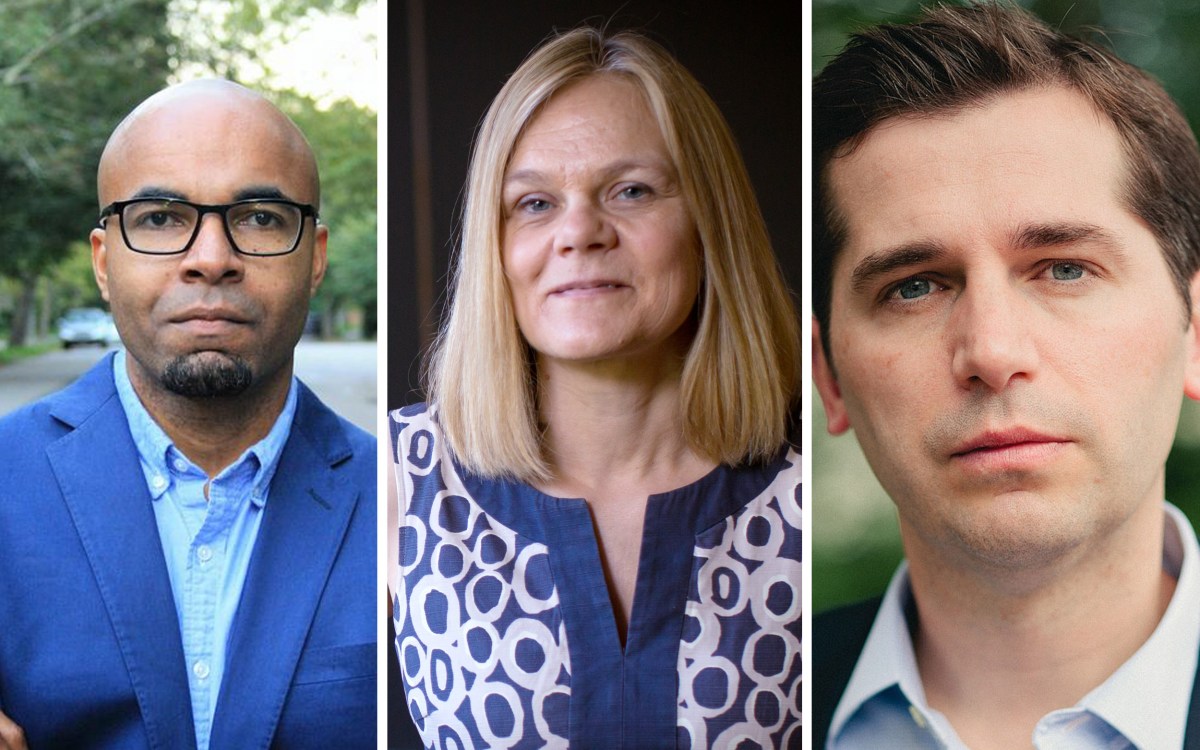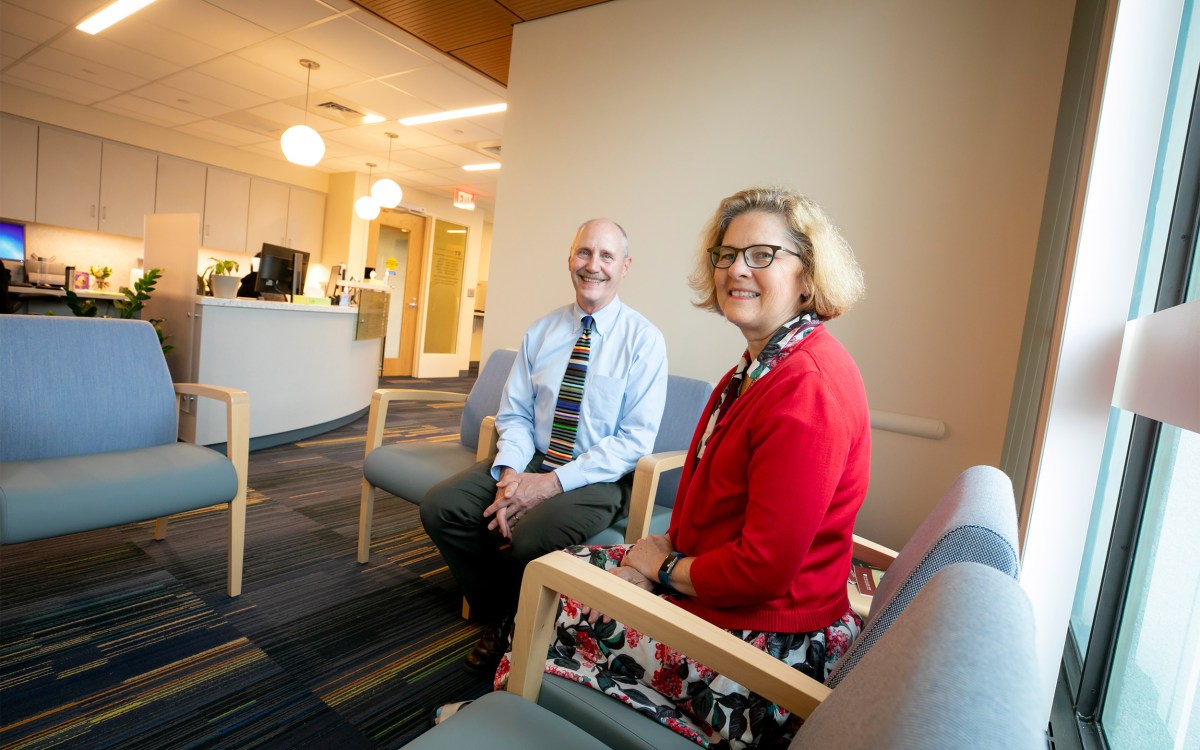
Anne Harrington discusses the treatment of mental disorders from its early years to present day in her book “Mind Fixers: Psychiatry’s Troubled Search for the Biology of Mental Illness.”
Stephanie Mitchell/Harvard Staff Photographer
‘An era where it has never not been about drugs’
Professor Anne Harrington’s new book tackles the rise of biological psychiatry
Franklin L. Ford Professor of the History of Science and director of undergraduate studies, Anne Harrington, has watched the field of mental health evolve over decades, and its struggles to reach a consensus on basics such as the root causes of and best treatments for mental illnesses. Since the days of Sigmund Freud, various factions of psychiatry have battled to define the discipline.
In her latest book, “Mind Fixers: Psychiatry’s Troubled Search for the Biology of Mental Illness,” Harrington chronicles the fall of the Freudians and the rise of biological psychiatrists, and with them the explosion of Prozac, Xanax, and Big Pharma’s pioneering technologies to map the brain. What never arrived: the results biological psychiatrists had promised.
Harrington spoke to the Gazette about the stumbles, the Prozac revolution, and how her own students provided the impetus to write the book.
Q&A
Anne Harrington
GAZETTE: The dedication in “Mind Fixers” mentions that Harvard students’ questions inspired you to write on this topic. How did your students conceptualize mental illness?
HARRINGTON: I was persuaded some years ago to develop and teach a general education course called “Madness and Medicine.” I’ve taught it now for well over 10 years, and very few of the students who come into that course think they’re particularly interested in history, but a lot of them have a strong interest in the world of mental health care. Maybe it’s because of family members, or because they just live in a world where many people use antidepressants, everyone suffers from anxiety. They live in a world where mental health concerns are ubiquitous and every single one of them has never known a world in which the approach to thinking about these problems isn’t biological. They’re also growing up with messaging that tells them there’s a lot to distrust when it comes to psychiatry and that Big Pharma is out to trick us all.
GAZETTE: So you wanted to correct your students’ polarized view of mental illness and psychiatry?
HARRINGTON: I wanted to arm them with a way of making sense of their own world. Over the years teaching “Madness and Medicine,” I came to believe I wasn’t doing justice to the specific story of how, why, and when we pivoted so dramatically toward the biological. I couldn’t find good answers in the literature and I didn’t completely understand the pivot myself. “Mind Fixers” is my effort to make sense of this for my own scholarly reasons but, above all, to make sense of it for my students and people like my students.
“The differences here may lie in the culture of a generation that has grown up in a world where so many people are on antidepressants and taking drugs for their ADHD. They have all come of age in an era where it has never not been about drugs.”
GAZETTE: How did this swing to a biological model happen so quickly in the 1990s?
HARRINGTON: Freudian psychiatrists who came of age during the Second World War were able to convince government, the VA system, and large numbers of medical schools that they had the future in their bones and they, not the biological psychiatrists, were best suited to deal with the postwar challenges of mental health. These challenges were largely seen as political problems. How do we deal with forces that might fray the fabric of democracy? How do we deal with delinquency? How do we deal with prejudice? How do we deal with the crisis of masculinity and homosexuality and all these things that will make us less suited to maintain our strength in the nuclear age? So the Freudian psychiatrists came to ascendancy, were hugely ambitious, and largely set the direction for research for the next generation.
GAZETTE: But as “Mind Fixers” points out, the Freudians couldn’t deliver on their promise of revolutionizing mental health. Is this what helped swing the pendulum dramatically back toward a biological reading of mental illness?
HARRINGTON: There was a series of specific debacles that were hugely embarrassing for the profession. One concerned the decision to remove homosexuality from the Diagnostic and Statistical Manual of Mental Disorders [DSM] in the 1970s by vote. If people could vote diseases in and out, some wondered what kind of medical profession this was. There was a very high-profile article in the 1970s that appeared in Science called “On Being Sane in Insane Places” that basically involved a social scientist sending stooges into hospitals and making up symptoms that had never been described in any kind of diagnostic manual, and all of them were admitted to the hospitals. The minute they were admitted, they started acting completely normal but some of them were in for weeks and weeks. It was hugely embarrassing not to be able to determine between sane and insane people. Then insurance companies started asking why we should make reimbursements if psychiatrists can’t tell who is sick and who isn’t.
GAZETTE: It sounds like opportunity played the huge role in biological psychologists reasserting their influence. What kind of promises did they make?
HARRINGTON: They said, “The Freudians brought the profession to the brink of professional suicide and we biological psychiatrists need to get things back to brass tacks.” In a sense they came in on a platform of common sense and said, “Of course mental illnesses are real. Of course psychiatry is a medical profession. Of course diagnostics are important, and we need to be doing research into the biological basis of mental illness.” The hope was that firm understanding of specific mental disorders would quickly emerge, once they had the support they wanted, but, over and over again, the hope was disappointed. There have been lots of cool findings, but they have varied across studies and proved hard to replicate and interpret. And it has been more difficult than people thought to apply them in any practical way to on-the-ground clinical work.
GAZETTE: Why does the idea persist that the pharmaceutical industry and psychiatry are too close to one another?
HARRINGTON: For at least two reasons. The drug companies played an important role in amplifying the message of the new biological orthodoxy. And they were able to amplify the orthodox understandings of the profession to a greater degree than had been the case with the earlier Freudian messages [though drugs were sold then too] because they were now able to advertise directly to consumers. They successfully agitated in the ’90s for the right to directly market to consumers through the TV ads we have all seen. But that’s not all. Many of the newly empowered biological psychiatrists, having now made drugs so central to their new biological professional identities, were persuaded to align their fortunes with the drug companies. This development also tracked a loosening of boundaries more generally between industry, the professions, and the academy in the ’80s and ’90s. To give a sense of just how many of them went this way: In 2008, newly required disclosure reports were filed by 273 speakers at the annual meeting of the American Psychiatric Association. The reports revealed that, between them, they had signed 888 consulting contracts and 483 contracts to promote products for one or another drug company.
GAZETTE: How did Prozac and Zoloft take off so quickly?
HARRINGTON: Prozac was marketed and widely understood to be a breakthrough drug, a brand-new antidepressant. As I read it, it wasn’t a brand-new kind of antidepressant. It was just a variant on the older tricyclic class of antidepressants. But then Peter Kramer comes out with “Listening to Prozac” and says this is a new drug that we’ve never seen before and it’s making people happier, with better personalities. There was a whole glamour period around the antidepressants. But behind the scenes was the recognition by drug companies that these drugs are going to go off patent and they have nothing new in the pipeline. So what do they do? They look at the DSM and find disorders that have not been claimed by any particular drug and try to see if they can find evidence their drug might work for this disorder or that disorder. And they specifically focus on a whole new suite of disorders in the area of anxieties. In other words, the antidepressants are made over into anti-anxiety drugs. But they’re exactly the same drugs. In fact, if you look at the ads for Zoloft in the early 2000s, with the blob under the cloud, five years later that same little blob is showing up at a party with people dancing the conga and he’s so embarrassed and inhibited and miserable until he takes Zoloft. This is one of the reasons why psychiatry and Big Pharma are seen as being in cahoots with each other.
GAZETTE: Do you see your students today thinking of mental illness differently than they did 10 ago when you started teaching “Madness and Medicine”?
HARRINGTON: I think many students feel stigmatized less by the process of being medicalized than they do by prospect of being hospitalized. Lots of people in their circles are on medication so I think stigma has diminished around that. But there’s still a big stigma if you end up, say, in McLean [Hospital]. The differences here may lie in the culture of a generation that has grown up in a world where so many people are on antidepressants and taking drugs for their ADHD. They have all come of age in an era where it has never not been about drugs.







